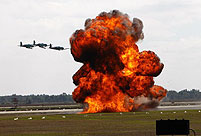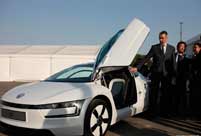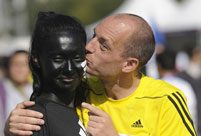BEIJING, Nov. 1 (Xinhua) -- The replacement of coal-powered heating systems with electric and gas-fired versions is expected to bring more breathing space for Beijing residents this winter, a season when they have commonly suffered a recurrent choking smog in the past.
But heating quality will not be compromised even if the city's air pollution is heavy, said an official with the Beijing Municipal Commission of City Administration and Environment during a meeting on Thursday.
A heating plant in a research institute in the city's north has just bid farewell to heaps of coal that used to jam its entrance in winter. Residents of many city-center bungalows no longer face breaking out in a cold sweat over storing enough honeycomb briquettes against winter chills.
"We must complete our work in two weeks before the city's central heating supply kicks off," said Wang Cheng, an official from the State Grid Corporation of China, giving on-site orders in Xi'anfu Hutong for the "coal-to-electricity" project.
This scheme, launched in 2008 by the municipal government, aims to replace coal-burning stoves with electric heaters for residents living in bungalows.
A total of 440,000 such households in downtown areas will be upgraded to electric heating before Nov. 15, according to an action plan of the municipal government.
Over 2,000 workers from the State Grid are currently scattered across the city, busy installing equipment and constructing facilities.
"The room temperature is 10 celsius degrees higher compared with coal heating," said a bungalow resident surnamed Chen, whose indoor heating was upgraded last year.
Tan Daoliang, director of a neighborhood committee in Beijing's Xicheng District, calculated that an ordinary 20-square-meter bungalow needs 1,800 yuan (about 295 U.S. dollars) a year for coal-burning heating, and 1,900 yuan for electric heating.

 Annual airshow kicks off in Houston
Annual airshow kicks off in Houston U.S. Navy Carrier Strike Group stages military exercises
U.S. Navy Carrier Strike Group stages military exercises Volkswagen showcases new energy vehicles in Beijing
Volkswagen showcases new energy vehicles in Beijing  How should we get married nowadays?
How should we get married nowadays?  Commentary:
Commentary: Jakie Chan sees Rubber Duck off in Beijing
Jakie Chan sees Rubber Duck off in Beijing Lingerie show dazzles Wuhan Motor Show 2013
Lingerie show dazzles Wuhan Motor Show 2013  Running in fun customs at Beijing Int'l Marathon
Running in fun customs at Beijing Int'l Marathon  Weekly Sports Photos
Weekly Sports Photos Unveil PLA air force base
Unveil PLA air force base  Say goodbye to tube-like apartment building
Say goodbye to tube-like apartment building Oriental education or western education?
Oriental education or western education? China in autumn: Kingdom of red and golden
China in autumn: Kingdom of red and golden National Geographic Traveler Photo Contest
National Geographic Traveler Photo Contest Chinese screen goddesses from Beijing Film Academy
Chinese screen goddesses from Beijing Film Academy Day|Week|Month